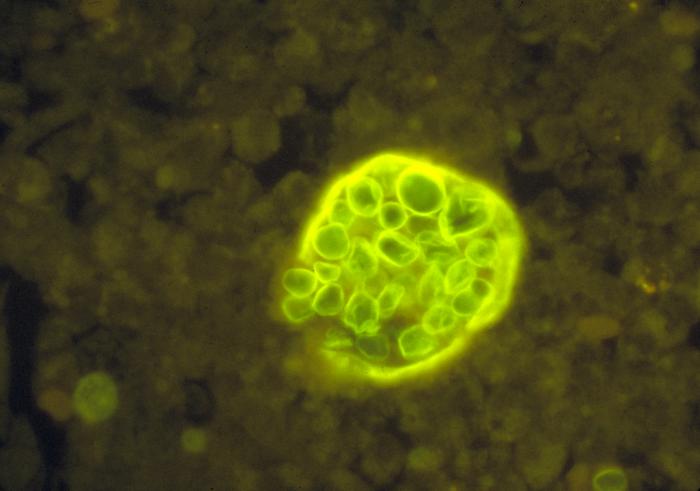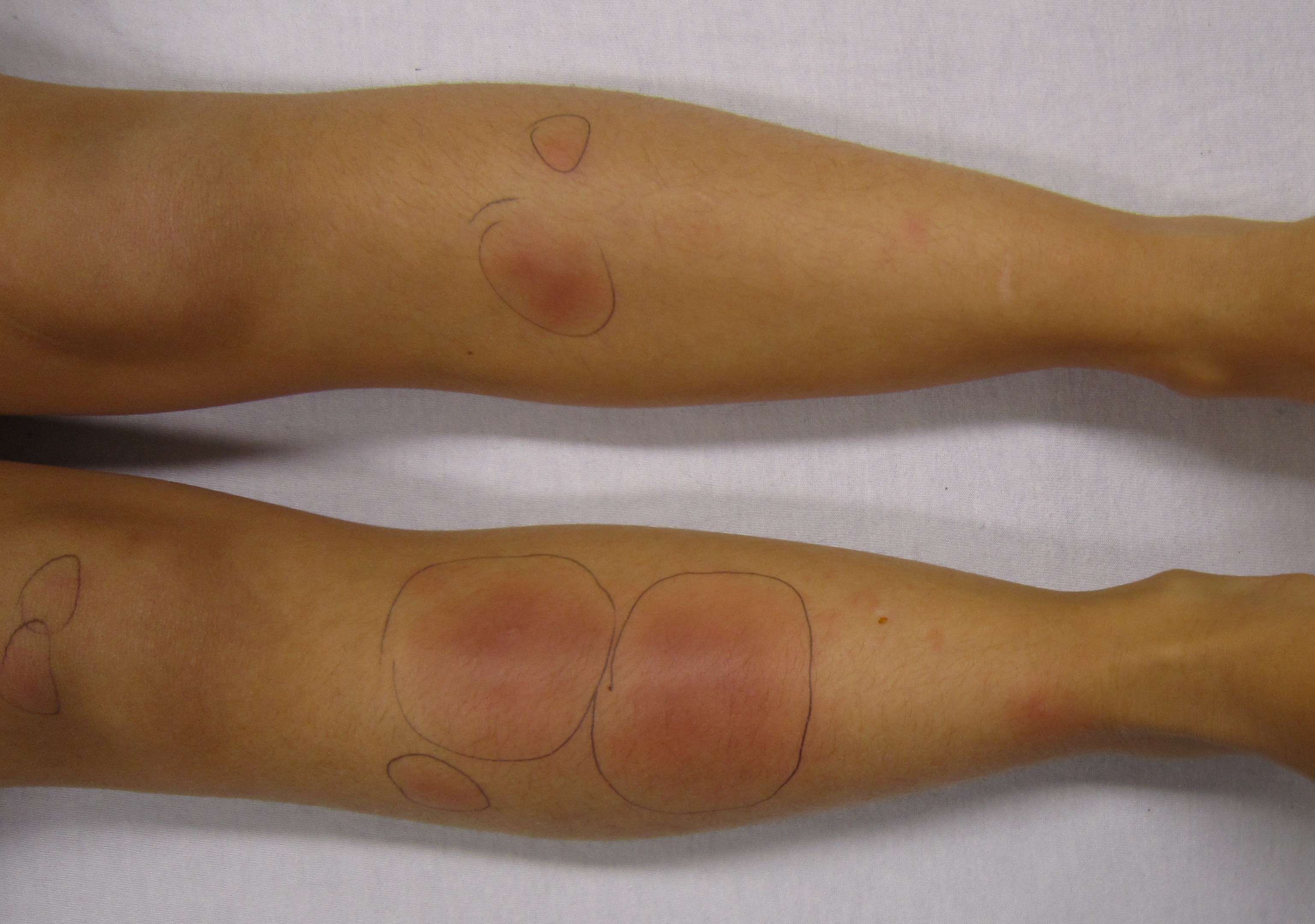WBR0188: Difference between revisions
Jump to navigation
Jump to search
No edit summary |
No edit summary |
||
| Line 21: | Line 21: | ||
|MainCategory=Microbiology | |MainCategory=Microbiology | ||
|SubCategory=Infectious Disease | |SubCategory=Infectious Disease | ||
|Prompt=A 65-year old woman | |Prompt=A 65-year old woman presents to urgent care for fatigue, myalgias, cough and fever. She reports a forty year smoking history, but has no otherwise remarkable past medical history. She emigrated from Mexico as a teenager and has been a migrant worker in southern california since. Three weeks ago, her home was destroyed in an earthquake and she has been living with her son. Physical exam reveals an erythematous rash on the lower limbs (pictured below). A chest radiograph reveals multiple nodules and hilar adenopathy. Which of the following is most likely to be seen on microscopic examination of a lung tissue biopsy? | ||
[[File:WBR0188prompt.jpg]] | |||
|Explanation=The causative organism in this case is coccidioides immitis. The diagnostic clues here are southwest U.S., migrant worker, erythematous skin rash and the multiple calcifying lesions.The diagnostic form in tissue is a spherule with endospores (pictured below). Although lesions in histoplasma capsulatum infection have a tendency to calcify as they heal, it does not form the characteristic spherule seen in coccidioides immitis. | |Explanation=The causative organism in this case is coccidioides immitis. The diagnostic clues here are southwest U.S., migrant worker, erythematous skin rash and the multiple calcifying lesions.The diagnostic form in tissue is a spherule with endospores (pictured below). Although lesions in histoplasma capsulatum infection have a tendency to calcify as they heal, it does not form the characteristic spherule seen in coccidioides immitis. | ||
<br> | <br> | ||
| Line 36: | Line 38: | ||
|AnswerE=Monomorphic encapsulated yeast | |AnswerE=Monomorphic encapsulated yeast | ||
|AnswerEExp=Monomorphic encapsulated yeast describes Cryptococcus neoformans. | |AnswerEExp=Monomorphic encapsulated yeast describes Cryptococcus neoformans. | ||
|EducationalObjectives=Coccidioides immitis is a pathogenic fungus endemic to the Southwestern U.S | |EducationalObjectives=Coccidioides immitis is a pathogenic fungus endemic to the Southwestern U.S that causes pulmonary disease and appears microscopically as spherules with endospores. | ||
|References=First Aid 2014 page 146 | |References=First Aid 2014 page 146 | ||
|RightAnswer=B | |RightAnswer=B | ||
|WBRKeyword=Microbiology, Eukaryotes, Yeast, Coccidioidomycosis, C immitis, Coccidioides immitis, Valley fever, | |WBRKeyword=Microbiology, Eukaryotes, Yeast, Coccidioidomycosis, C immitis, Coccidioides immitis, Valley fever, | ||
|Approved= | |Approved=Yes | ||
}} | }} | ||
Revision as of 03:28, 1 November 2014
| Author | [[PageAuthor::Ogheneochuko Ajari, MB.BS, MS [1]]] |
|---|---|
| Exam Type | ExamType::USMLE Step 1 |
| Main Category | MainCategory::Microbiology |
| Sub Category | SubCategory::Infectious Disease |
| Prompt | [[Prompt::A 65-year old woman presents to urgent care for fatigue, myalgias, cough and fever. She reports a forty year smoking history, but has no otherwise remarkable past medical history. She emigrated from Mexico as a teenager and has been a migrant worker in southern california since. Three weeks ago, her home was destroyed in an earthquake and she has been living with her son. Physical exam reveals an erythematous rash on the lower limbs (pictured below). A chest radiograph reveals multiple nodules and hilar adenopathy. Which of the following is most likely to be seen on microscopic examination of a lung tissue biopsy? |
| Answer A | AnswerA::Broad based budding yeast |
| Answer A Explanation | AnswerAExp::Broad based budding yeast is seen in Blastomyces dermatitidis. |
| Answer B | AnswerB::Spherules with endospores |
| Answer B Explanation | AnswerBExp::Spherules with endospores characteristically describes Coccidioides immitis. |
| Answer C | AnswerC::Septate hyphae branching dichotomously at acute angles |
| Answer C Explanation | AnswerCExp::Septate hyphae branching dichotomously at acute angles describes Aspergillus fumigatus. |
| Answer D | AnswerD::Non septate hyphae with broad angles |
| Answer D Explanation | AnswerDExp::Non septate hyphae with broad angles describes Mucor species. |
| Answer E | AnswerE::Monomorphic encapsulated yeast |
| Answer E Explanation | AnswerEExp::Monomorphic encapsulated yeast describes Cryptococcus neoformans. |
| Right Answer | RightAnswer::B |
| Explanation | [[Explanation::The causative organism in this case is coccidioides immitis. The diagnostic clues here are southwest U.S., migrant worker, erythematous skin rash and the multiple calcifying lesions.The diagnostic form in tissue is a spherule with endospores (pictured below). Although lesions in histoplasma capsulatum infection have a tendency to calcify as they heal, it does not form the characteristic spherule seen in coccidioides immitis.

|
| Approved | Approved::Yes |
| Keyword | WBRKeyword::Microbiology, WBRKeyword::Eukaryotes, WBRKeyword::Yeast, WBRKeyword::Coccidioidomycosis, WBRKeyword::C immitis, WBRKeyword::Coccidioides immitis, WBRKeyword::Valley fever |
| Linked Question | Linked:: |
| Order in Linked Questions | LinkedOrder:: |
